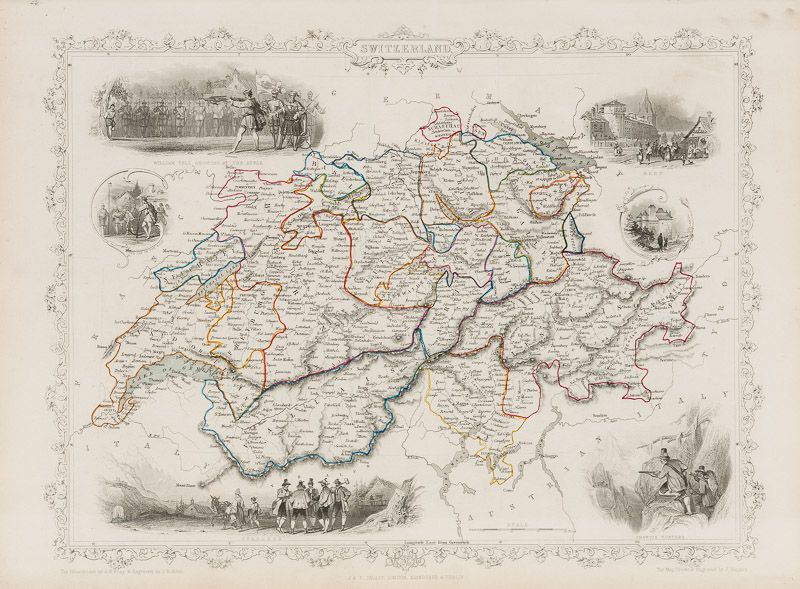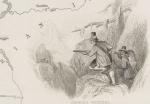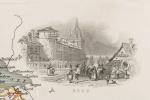Tallis, Switzerland - With Vignettes of William Tell Shooting at the Apple, Bern
Switzerland – With Vignettes of William Tell Shooting at the Apple, Bern, Castle of Cillon, Chamois Hunters, Tyrolese and the Cap on the Pole.
Original steel engraving / Vintage map. Drawn and engraved by John Rapkin. Partly hand-coloured. Illustrations by A.H. Wray and engraved by J.B Allen. London, Edinburgh and Dublin, J & F. Tallis, 1851. Plate Size: 32.2 cm x 25 cm. Sheet Size : 37.4 cm x 27.3 cm. In very good+ condition with only faintest traces of browning to edges. Slight paper imperfections to top edge. Very minor smudges to top right corner.
Published in the Illustrated Atlas, And Modern History Of The World Geographical, Political, Commercial & Statistical, Edited By R. Montgomery Martin.
Beautiful and interesting map of Switzerland with the political subdivisions delineated. The Swiss Cantons such as Vallais, Zurich and Appenzell are all shown. Cities such as Geneva, Basel and Zurich can all be seen. The Swiss rivers and lakes such as Lake Geneva, Neuchatel, and the Bodensee (Lake Constance) are shown on the map. Relief shown pictorially. France, Germany, Austria and Italy are all bordering Switzerland.
John Tallis (7 November 1817 – 3 June 1876) was an English cartographic publisher. His company, John Tallis and Company, published views, maps and atlases in London from roughly 1838 to 1851.
Tallis set up as a publisher with Frederick Tallis in Cripplegate in 1842; the business moved to Smithfield in 1846, and was dissolved in 1849. From 1851 to 1854 Tallis operated as John Tallis and Company. He started The illustrated news of the world and national portrait gallery of eminent personages in 1858, selling it for £1,370 in 1861; it folded in 1863. (Wikipedia)
The most important project John Tallis undertook, was the ‘Illustrated Atlas’ from 1851. The original map we offer here, was part of this exceptional Atlas and all the maps it contained are still today considered as the last reminder of an era of lavish map production. Tallis worked the project together with John Rapkin (1815-1876) and it was Rapkin’s style and talent that we have to thank for when we marvel at these maps today. What makes these maps so special is the detail of engraved vignettes that surround the map and often show indigenous scenes, people in their environment and even more so, historical buildings or historical views of towns and cities, architecture and landscape.
The project of ‘The Illustrated Atlas’ was designed to be finished just in time for the anxiously awaited “Great Exhibition of the Works of Industry of All Nations” or The Great Exhibition, sometimes referred to as the Crystal Palace Exhibition in reference to the temporary structure in which it was held, was an international exhibition that took place in Hyde Park, London, from 1 May to 11 October 1851. It was the first in a series of World’s Fairs, exhibitions of culture and industry that became popular in the 19th century, and it was a much-anticipated event.
The Great Exhibition was organized by Henry Cole and Prince Albert, husband of the reigning monarch, Queen Victoria. It was attended by numerous notable figures of the time, including Charles Darwin, Samuel Colt, members of the Orléanist Royal Family and the writers Charlotte Brontë, Charles Dickens, Lewis Carroll, George Eliot and Alfred Tennyson. Music for the opening was under the direction of Sir George Thomas Smart and the continuous music from the exhibited organs for the Queen’s procession was “under the superintendence of William Sterndale Bennett”. (Wikipedia)
- Keywords: 19.Jahrhundert · 19th Century · 19th Century Map · Alps · Cartography · Catalogue No.5 – Maps of the World · Constantinople · Europe · Geneva · John Tallis Maps · Map · Original Map · Original Maps · Original Steel Engraving · Originale Landkarte · Rare Map – Switzerland · Swiss history · Switzerland · Travel Europe – Rare · Vintage Map · Vintage Old Map
- Language: English
- Inventory Number: 200056AG
EUR 275,--
© 2025 Inanna Rare Books Ltd. | Powered by HESCOM-Software
















